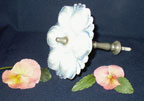
 |
Curtain Call to Towel
Holder
|
Before efficient home
heating and modern insulation, heavy drapes were a natural solution to keep
out the cold and keep in whatever heat could be generated from the fireplace
or wood stove. Those same drapes, however, became a hindrance to taking advantage
of the sun’s light and warmth during the day. The devices used to hold
those drapes back when light became more important than temperature were called
“curtain pins”.
Curtain tiebacks, as we now refer to them, were made of just
about anything that would accomplish the task at hand, and when in the early
1800s, pressed (molded) glass was invented in New England, some beautiful forms
of these essentials were one of the first practical products of the fledgling
American glass industry.
The “pressed curtain pin” one of the earliest products of the Boston
& Sandwich Glass Company on Cape Cod was molded into forms we now refer
to as “patterns” with some of the designs of curtain pins also being
used for furniture knobs or drawer pulls. Examples of the most common pattern,
Pressed Rosette, or what most now refer to as Petal & Shell, are seen here.
The decorative glass part of the pin utilized a metal
fixture with a screw that fastened into the woodwork on the side(s) of the window.
In one type, the end of the pin that passes through the glass face is threaded
and a metal cap secures the glass face to the pin. In a less common type of
tieback, instead of the metal showing on the front of the glass, a metal nut
was embedded in the back center of the glass into which a metal pin was screwed.
Several sizes were available, from 1 1/2” in diameter
to a very heavy, very rare 8”, depending on the volume of material to be
managed, with most common being the 4” size. The larger sizes were used
in theaters to hold back stage curtains. The early glass pieces were made in
clear, canary (vaseline), fiery opalescent and opaque white (originally called
“pearl”, what we now call “opal” or “milk glass”).
It is possible to find these historical artifacts today
but very difficult to find them in undamaged condition. The original glass used
was “flint” glass, or “leaded” glass. This early glass was
brittle and, while the pieces came into contact with soft material in the beginning,
most have been less graciously handled in the past 100 years.
From these initial simpler commodities of knobs, cup
plates and salt dips, the American pressed glass industry grew and developed
the skills necessary to make larger molds creating the beginnings of pressed
glass dishes known today as pattern glass or EAPG, Early American Pattern Glass
1850-1910 - the very first distinctly American mass manufactured product.
The Pressed Rosette (Petal & Shell) pattern, with
alternating petals and three-lobed plumes, are being highly reproduced today
in many colors, but as early as 1911, there were reports of clear and white
opalescent “repros” in two sizes.
The reference for much of the above information is The
Glass Industry in Sandwich, Volume 5, by Barlow and Kaiser.
In our home we don't need tiebacks to hold back curtains, but we use them individually
as towel holders in the kitchen and bathrooms.